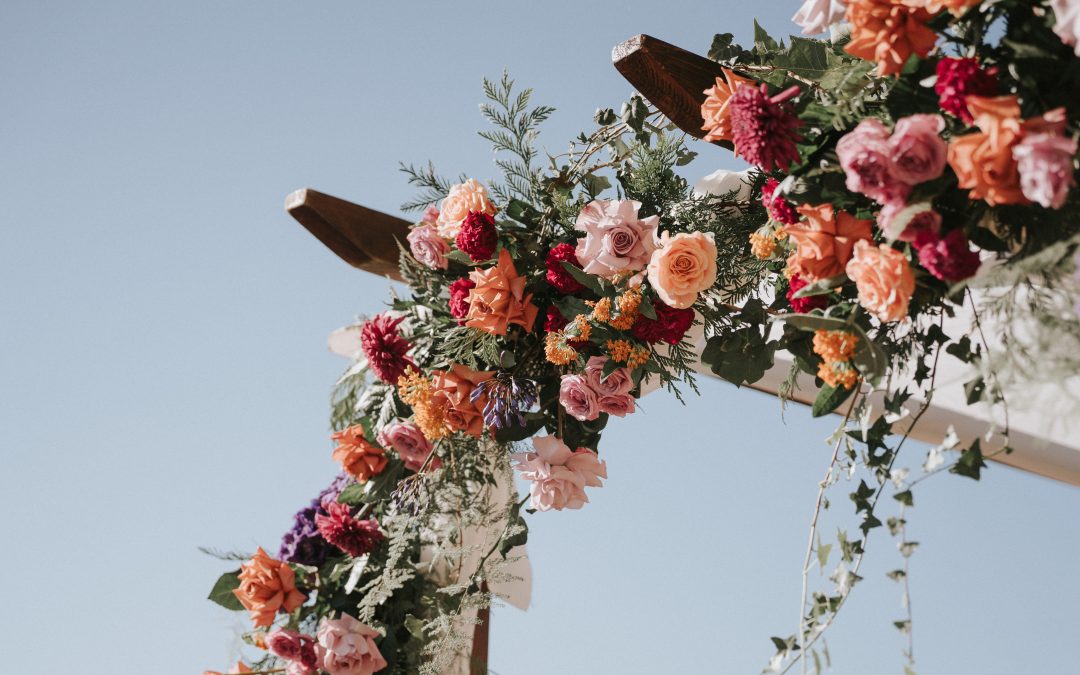Why to choose local and seasonal flowers for your wedding in spain
This week, we had the pleasure of interviewing Stela at her organic flower farm, Floritea, to learn more about the benefits of choosing local, seasonal, and organic flowers for weddings and events.
Back in 2019, Stela co-founded the Collective of Ecological Flower Growers of Catalonia, a group of professionals dedicated to sustainable, locally grown, and seasonal flowers. Pioneers in the field of eco-friendly floriculture, they cultivate unique varieties rarely found in traditional flower markets and regularly host conferences for those interested in sustainable flower farming.
1. Where do most flowers used for floral decorations come from?
Based on the data I’m familiar with, about 70% of flowers sold in our country are imported—mainly from the Netherlands, Colombia, Ecuador, Kenya, and even Japan.
When it comes to event flowers, that percentage is likely even higher.
Most floral designs for events start with a client’s preference for a specific flower, rather than considering seasonality and what’s naturally available at the time. Both florists and clients still have a long way to go in understanding and embracing seasonal flowers and sustainable consumption.
One of the main reasons to use seasonal flowers is that they are at their peak beauty, last longer, and blend harmoniously with the surroundings.
2. What is a flower farm and how does local flower farming differ from imported flowers?
The term “flower farm” is a literal translation from English, though some might find the word farm unusual when talking about flowers. But for me, it feels completely natural—flowers are living things that require care and attention, just like any other crop.
I also love referring to myself as a flower farmer because I feel deeply connected to the land. It’s where I come from and who I truly am.
Most flower farms I know sell their flowers locally, sometimes nationally, but never beyond that. If we truly want to be a sustainable society, the 70% import rate should be reversed—imported flowers should be a rare luxury for special occasions, not an everyday commodity.
The key difference between local vs. imported flowers is the resources required to get them into a vase on your table.
Imported flowers are often grown intensively to reduce costs, require long-term refrigeration, and travel thousands of kilometers before reaching their destination—all of which severely impact the environment.
Local flowers help minimize some of these issues, but not all locally grown flowers are sustainable. That’s why it’s essential to choose local producers committed to environmentally friendly practices.
3. Tell us about your flower farm
My journey started as a personal need to reconnect with the earth and establish roots.
I was born in Moldova, Eastern Europe, in a small town where I helped my parents grow vegetables, fruits, and herbs.
At 15, I moved to Romania for my studies, then to Spain, spent some years in the Netherlands, and traveled extensively for work. For nearly two decades, I lived in rental apartments far from nature, and I deeply missed the connection to the land—planting, growing, and nurturing.
As I entered my 30s, I started questioning my life direction and career path.
Then, I stumbled upon Erin Benzakein from Floret, whose project truly inspired me. Through her, I discovered Maren from Horta de la Viola, who remains a role model to this day for her honest portrayal of the industry—both the highs and the struggles—and her commitment to sustainability.
Without overthinking, I decided to try flower farming myself.
In my first year, I rented a small plot of land and planted a variety of bulbs and annual flowers. The experience was so fulfilling that when my partner and I were searching for a home outside of Barcelona, we prioritized finding one with land to continue growing.
Right now, my flower farm is only 400 square meters, a small space that allows me to grow flowers exclusively for custom bouquets and weekly orders.
In the coming seasons, I’d love to rent a larger plot nearby to expand production, collaborate with local florists, and provide flowers for weddings and events.
4. What key elements define a truly sustainable floral arrangement for a wedding?
Since entering the floral industry, I’ve heard countless stories of allergic reactions and intoxications caused by flowers.
This is largely due to the pesticides and chemicals used not only in cultivation but also post-harvest treatments to extend their shelf life.
If you want to ensure that you and your guests don’t experience any reactions, opt for organic flowers.
However, sustainability goes beyond organic—it also means choosing local and seasonal flowers.
Locally grown flowers often include rare varieties that don’t survive long transportation, and many are naturally adapted to the local climate, requiring no artificial treatments to thrive at an event.
A floral design that harmonizes with the surroundings creates a natural, effortless elegance while reducing environmental impact.
5. What’s the process for helping couples create their ideal wedding floral design?
If a couple wants a sustainable wedding, they need to be flexible when choosing flowers.
Why? Because weddings are often planned months in advance, but nature follows its own rhythm.
For seasonal farming, timing can shift by ±2 weeks—so the first step is educating clients on flower seasonality and sustainable sourcing.
Next, we guide them through flower varieties, color palettes, shapes and characteristics
For example, some flowers—like poppies—are absolutely stunning but only last a day once cut, so we help couples find the best options for their needs.
6. What advice would you give couples looking to minimize the environmental impact of their wedding florals?
Hiring a florist committed to sustainability is essential.
Beyond choosing seasonal and local flowers, it’s also crucial to consider the mechanics used in floral arrangements.
For a low-impact floral design, we should eliminate single-use materials as much as possible.
A major offender is floral foam, which is highly polluting and widely used in floral installations. It should be replaced with eco-friendly alternatives, such as wire mesh, water tubes, hardy flowers that don’t require hydration and potted plants.
Another key tip: Choose a naturally beautiful venue that requires minimal decoration.
Reusing materials and being mindful of waste is fundamental, as floral arrangements often generate a lot of disposable waste.
7. How can couples repurpose their wedding flowers after the celebration?
Flowers are magical because they are ephemeral.
Just like in nature, their life is short, and that’s part of their beauty.
However, most flowers don’t die in a day, so we should make the most of them.
For me, the best way to extend their life is by sharing them with guests so they can enjoy them beyond the wedding day.
If the design incorporates both cut flowers and potted plants, guests (or the couple) can replant them in their garden or terrace, keeping the memory alive even longer.
Other creative ways to repurpose flowers include drying and pressing them or using them for natural fabric dyeing
It all depends on how much time and effort couples want to dedicate to preserving their floral memories.







